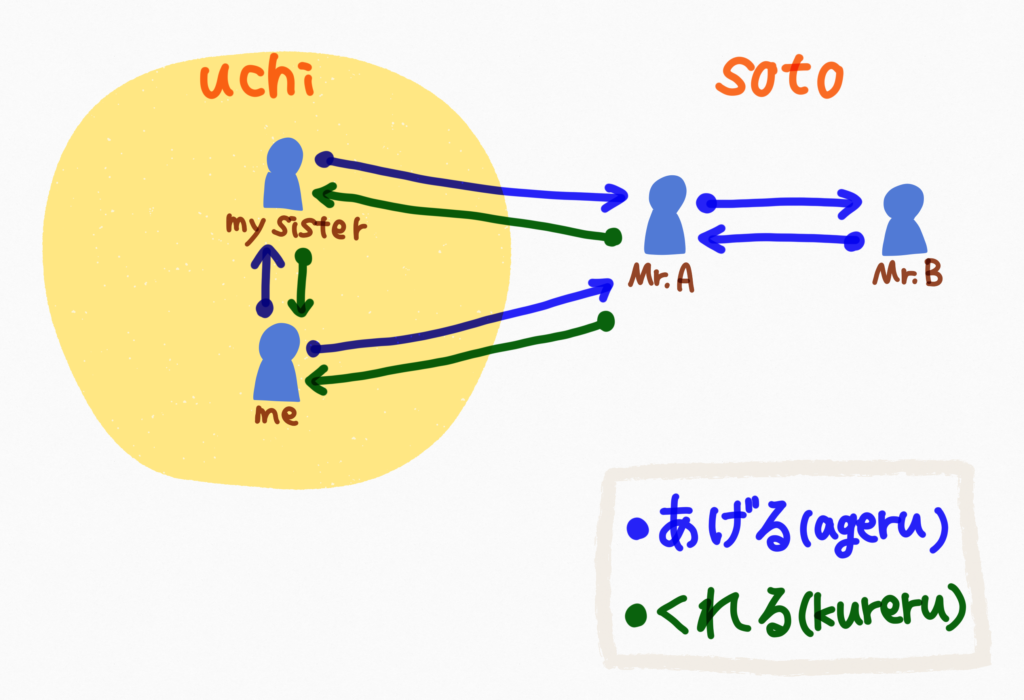
In English, we can use ‘to give’ and ‘to receive’ regardless who is giving and who is talking. Differently, in Japanese, there are two verbs for expressing ‘to give’: あげる (Ageru), くれる (Kureru); while ‘to receive’ is indicated by もらう (Morau). Here comes the question: What is the difference between them?
Basically, it depends on the point of view as well as the relationship between the giver, the receiver, and the speaker.
In order to fully understand this, it is better for you to understand the concept of 内 (uchi) and 外 (soto) first.
The word 内 (uchi) literally means inside, while 外 (soto) means outside.
内 (uchi) refers to you, your family, your friend, or anyone you are close with.
In contrast, 外 (soto) refers to the others or anyone besides your 内 (uchi).
| Verb (Basic Form) |
Verb (Past Form) |
Verb (Polite Form) |
Verb (Polite Past Form) |
Concept |
| あげる (ageru) |
あげた (ageta) |
あげます (agemasu) |
あげました (agemashita) |
‘I’ → Uchi ‘I’ → Soto Uchi → Soto Soto → Soto |
| くれる (kureru) |
くれた (kureta) |
くれます (kuremasu) |
くれました (kuremashita) |
Uchi → ‘Me’ Soto → ‘Me’ Soto → Uchi |
| もらう (morau) |
もらった (moratta) |
もらいます (moraimasu) |
もらいました (moraimashita) |
Anyone → Anyone |
 「あげる」
「あげる」
あげる (ageru) is used when the giver is the subject of the sentence.
When to use:
- I give to UCHI (g. I give to my friend)
- I give to SOTO (g. I give to the cashier)
- UCHI gives to SOTO (g. My mother gives to the cashier)
- SOTO gives to SOTO (g. Someone gives to the cashier)
Structure: Giver + は/が + Recipient + に + Object + を + あげる
Example:
私は友達に花をあげた。
Watashi wa tomodachi ni hana o ageta.
I gave a flower to my friend.
Note: in conversation, we usually leave out the ‘私は’ (watashi wa).
「くれる」
くれる (kureru) is also used when the giver is the subject of the sentence.
When to use:
- UCHI gives me (g. My friend gives to me)
- SOTO gives me (g. The cashier gives to me)
- SOTO gives to UCHI (g. The cashier gives to my mother)
Structure: Giver + は/が + Recipient + に + Object + を + くれる
Example:
友達は母に本をくれた。
Tomodachi wa haha ni hon o kureta.
My friend gave a book to my mother.
「もらう」
Luckily, there is only one version of ‘to receive’ in Japanese. We use もらう (morau) when the verb of the sentence is ‘to receive’. In other words, it is used when the receiver is the subject of the sentence.
Structure:
Giver + から + Object + を + もらう
Recipient + は/が + Giver + に + Object + を + もらう
Examples:
友達から土産をもらった。
Tomodachi kara miyage o moratta.
I received a souvenir from my friend.
For better understanding, let’s use the example from あげる (ageru).
私は友達に花をあげた。
Watashi wa tomodachi ni hana o ageta.
I gave a flower to my friend.
The sentence above has the same meaning as:
友達は私に花をもらった。
Tomodachi wa watashi ni hana o moratta.
My friend received a flower from me.
For the example from くれる (kureru).
友達は母に本をくれた。
Tomodachi wa haha ni hon o kureta.
My friend gave a book to my mother.
The sentence above has the same meaning as:
母は友達に本をもらった。
Haha wa tomodachi ni hon o moratta.
My mother received a book from my friend.
Supplementary
Japanese tends to omit the pronouns (e.g. I, you). Fortunately using Japanese, we can differentiate the pronouns clearly.
プレゼントをあげた。
(I) gave a present (to someone).
プレゼントをくれた。
(Someone) gave a present (to me).
プレゼントをもらった。
(I) received a present (from someone).
Let’s learn Japanese today! Join us at LingoCards!
